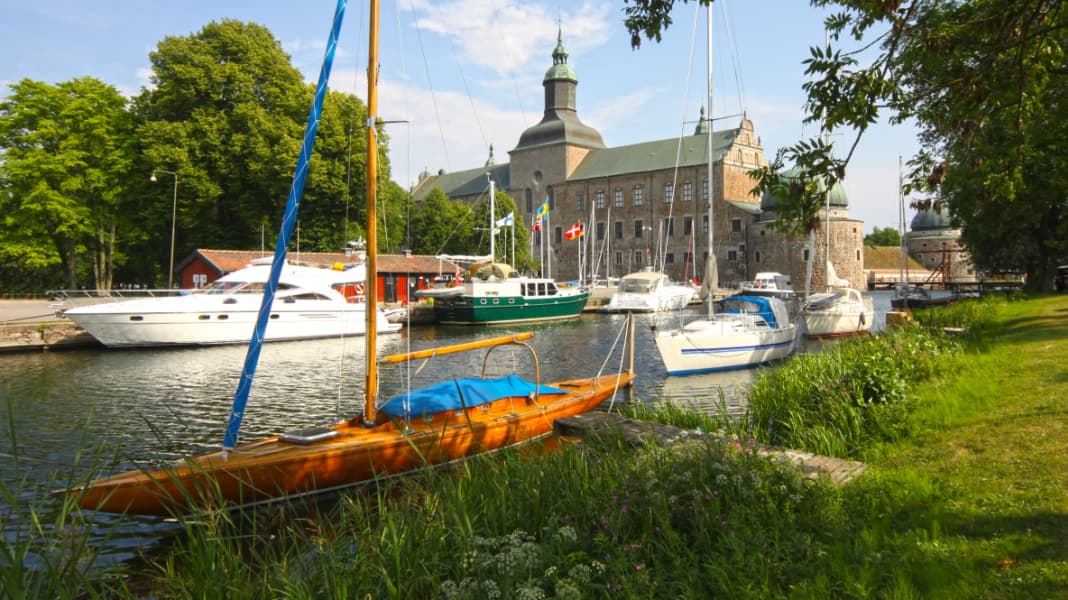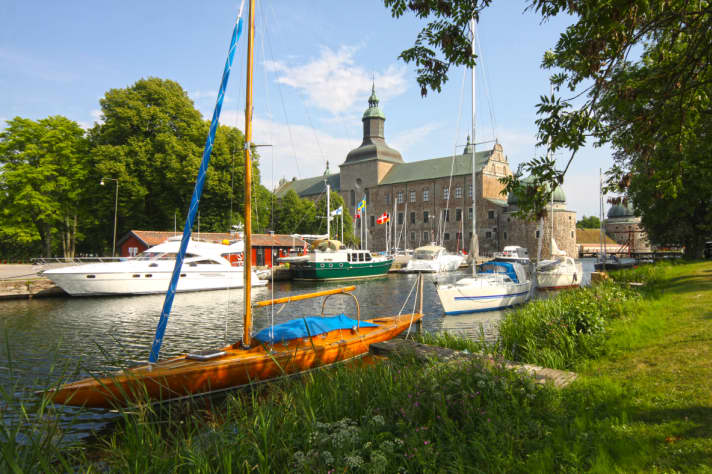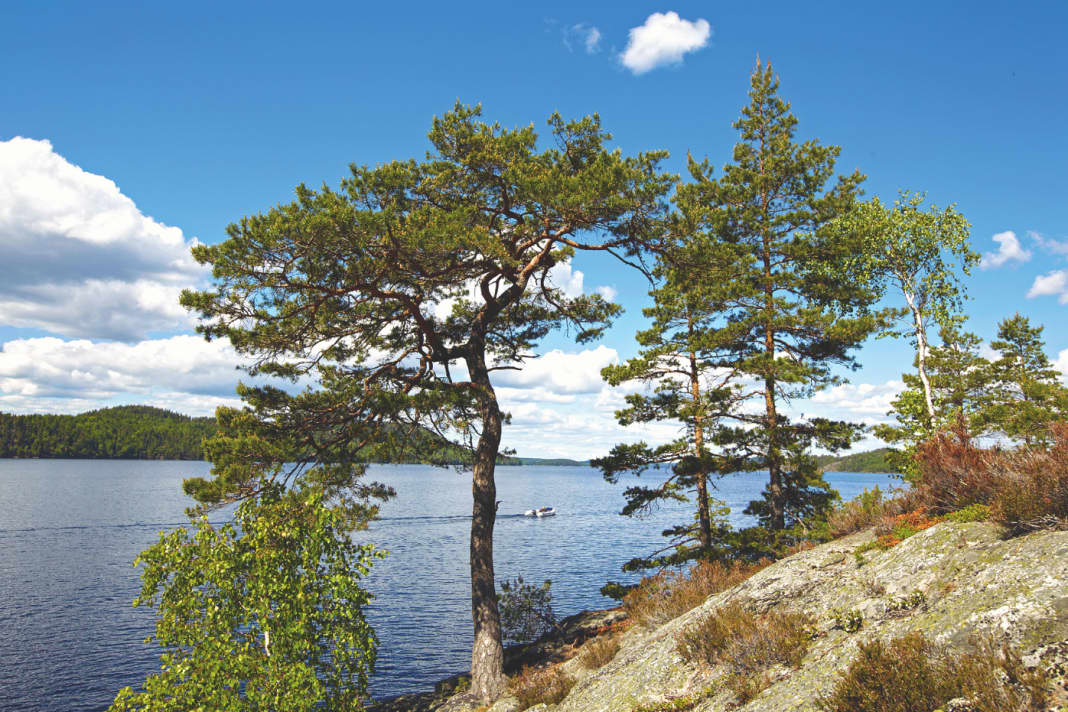







Dense forests, secluded islands and endless expanses of water: An extensive network of lakes and historic canals stretches across the south of Sweden, connecting the country's two coasts and allowing excursions far into the interior. If you are looking for a typical Scandinavian holiday experience on your own keel, you will find more than just one destination here!
Sweden's great lakes
The four large lakes of southern Sweden - Vänern, Vättern, Mälaren and Hjälmaren - are an attractive part of the waterway network and serve as links between the individual canals. They are among the largest lakes in Europe. Lake Vänern, which covers around 5500 square kilometres, is the third largest after Lake Ladoga and Lake Onega. It is ten times the size of Lake Constance and fifty times the size of Lake Müritz. Its largest extension is 130 km in a north-south direction and 80 km in a west-east direction. The coastline is 2000 kilometres long. Navigation can be correspondingly challenging; especially in bad and uncertain weather, Vänern (and to a lesser extent the other lakes) is more like a sea than an inland area. The shallow and archipelago-fringed coast is lighted. Up-to-date Swedish nautical charts are a must on board, even if the lakes are "only" to be crossed and not explored further.
Dalsland Canal
In the far west, on the border with Norway, stretches the Water system of the Dalsland Canal - certainly one of the most beautiful inland waterways in Europe. The name is deceptive: of its 250 kilometres, only 12 kilometres (with 31 locks) are man-made. If you add the tributaries such as the Töcksfors Canal in the north and Lake Silen, you quickly reach 400 kilometres. The 55 km long Stora Le stretches all the way into Norway. The historic Håverud aqueduct (opened in 1868) is one of Sweden's most famous engineering monuments. The canal flows into Lake Vänern at Köpmannebro.
Säffle canal
In the north-west of Lake Vänern, however, the Säffle canal and runs northwards for around 80 kilometres. Even the Vikings used this route, which today is regulated by just one lock. The northern third of the route runs across the Glafsfjord to the small town of Arvika.
Trollhättekanal
Sweden's only Waterway developed for large-scale shipping connects Lake Vänern with the Kattegat near Gothenburg. The approximately 80 km long route largely follows the natural course of the Göta Älv river, with six modern locks (including the Trollhättan lock stairs) overcoming a total height difference of 44 metres. The canal also forms the western section of the navigable coast-to-coast route known as the "Göta Canal".
Göta Canal
If you include the Trollhätte Canal and Lake Vänern, the Göta Canal Route over a length of around 400 kilometres across the south of Sweden. The actual Göta Canal, on the other hand, begins on the eastern shore of Lake Vänern, crosses Vättern and finally flows into the Baltic Sea 190 kilometres east of Söderköping. Opened in 1832, it still has 58 historic locks and is one of Sweden's biggest tourist attractions (on land and water). During the comparatively short season, it is correspondingly popular with sports skippers on the "Sweden round trip". One of the most famous points along the canal is the Berg lock staircase with its seven chambers.
Bergslag Canal
The only waterway "without a connection" to the rest of the network is the Bergslag Canal north-east of Lake Vänern. The tranquil 65 km long water system between the towns of Filipstad and Karlskoga comprises 16 lakes and five short canal sections with a total of six locks, which are operated by an association. Slipways for water hikers are available. www.bergslagskanal.se
Hjälmare Canal
The Hjälmare Canal is only 13 kilometres long Sweden's oldest artificial waterway. It was opened as early as 1639 during the reign of Gustav II Adolf and has connected Lake Hjälmaren with the larger Mä-
laren (and the Baltic Sea). Its nine locks overcome a total drop height of 22 metres. www.hjbf.se
Strömsholm Canal
No canal in Sweden leads further north than the 110 km long Strömsholm Canal. While ore used to be transported from the mines in the north, the canal with its 26 locks is now firmly in the hands of sport skippers. On the way down to the village of Strömsholm on the Mälaren, the difference in altitude is around 100 metres.
Kinda channel
If you have time for your Göta Canal tour, you can take a Side trip on the Kinda Canal which leads from Lake Roxen in a southerly direction. Here, too, it is more of a chain of lakes: only 6 km have been dug, the difference in level is around 50 m (15 locks). The tourist infrastructure along the 90 km long waterway is excellent.
Södertälje Canal
With a length of only about 5 km (1 lock) the shortest canal in Sweden. Abbreviation for vessels heading for the Mälaren on the Baltic Sea from the south.
Cruise preparation
Sweden's waterways are suitable for all types of pleasure craft - whether you are travelling on your own keel, with a trailer or with a dinghy in the boot. Travelling by car from northern Germany takes about a day. When planning your trip, please note the current opening times, which vary depending on the canal (season usually runs from the beginning/mid-June to the end of August/beginning of September).
There is a charge for use: A single lock costs around 50-70 Swedish kronor (6-8 euros); if you buy a ticket for the entire route, it is around a third cheaper. There are up-to-date and official information brochures (also in German) for most canals, which can be downloaded free of charge from the Internet and contain all times, prices and nautical information (boat dimensions, moorings).
Chartering in the district
As the season in the north is short and most guests come
guests come on their own keel, there are no large charter fleets of cabin cruisers and motor yachts on the Swedish inland waterways. Nevertheless, there are a few offers. Here are two examples:
Göta Canal and Kinda Canal In Vadstena (near Motala) on Vättern is the charter base of Vättern Canal Charter. The company offers six different cabin cruisers for round trips to Vänern or the Baltic Sea. Depending on the model, there is room for four to a maximum of eight people on board. Tel. 0046-708-54 05 15.
The Dalsland Canal On the Dalsland Canal, the Operating company of the canal itself a Nimbus 2600 (length: 8.45 m, 4+1 berths) stationed in Köpmannebro. Dalslands Kanal AB, Nils Ericsons väg 1, Upperud, SE-464 72 Håverud. Tel. 0046-530-447 50.

